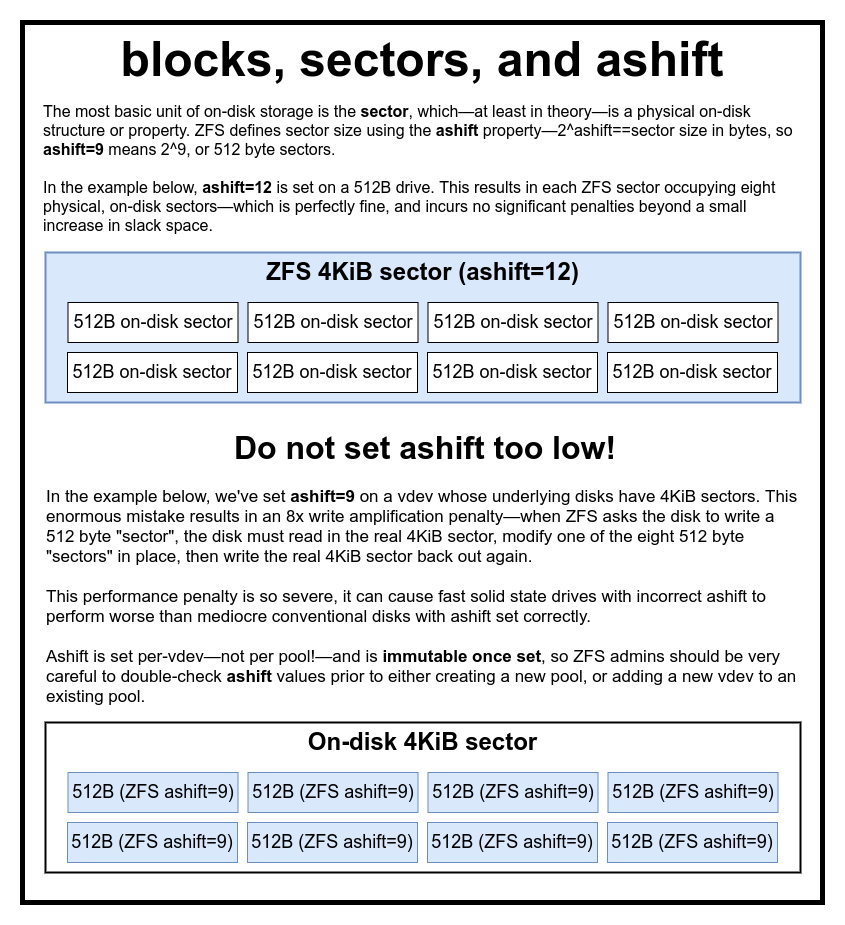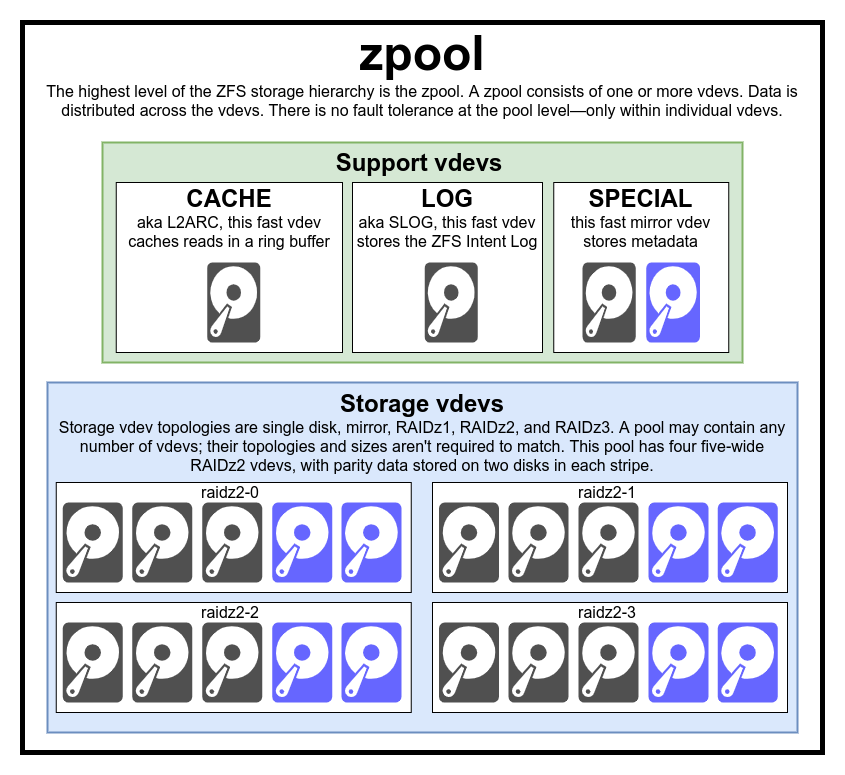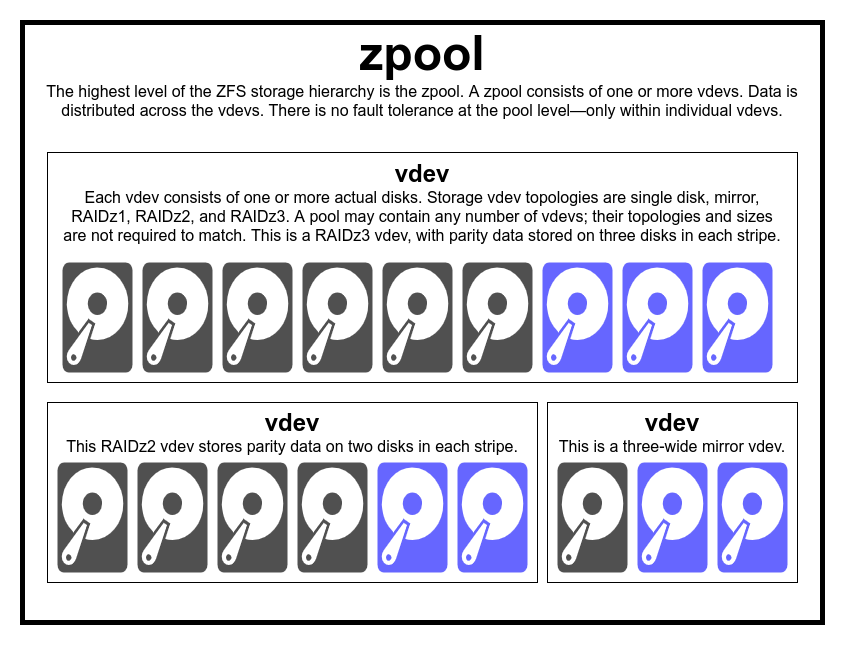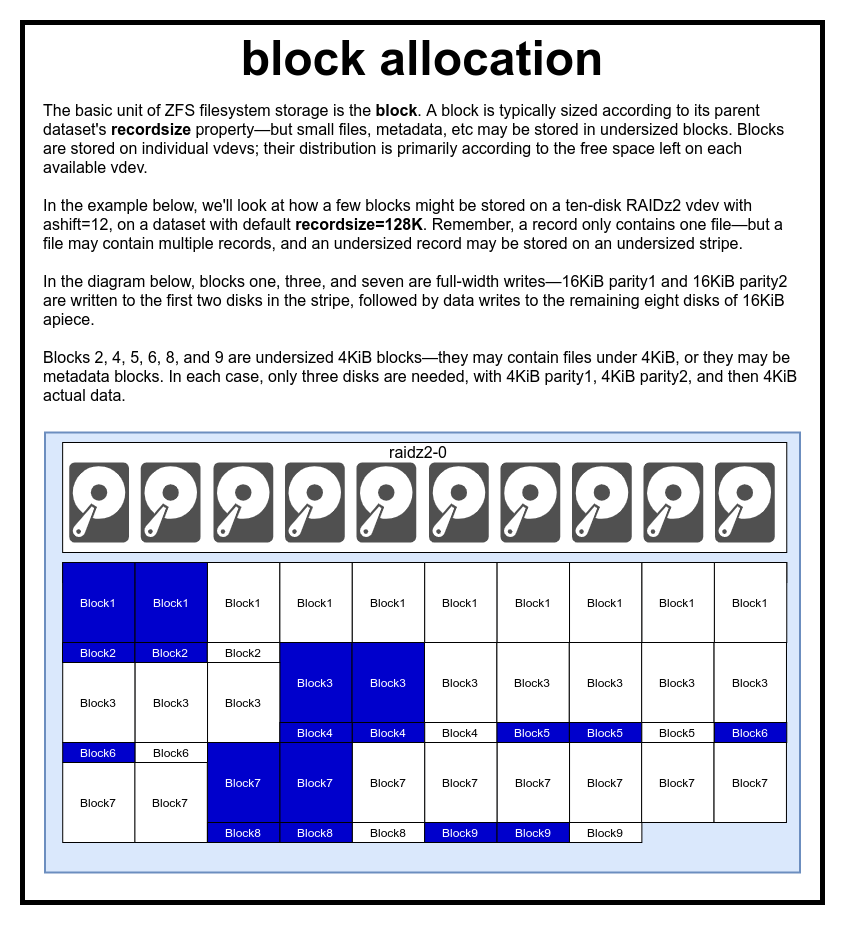ZFS Cheatsheet#
Resources#
Highlevel Guides#
- ZFS 101: understanding ZFS storage and performance
- ZFS Guide for starters and advanced users: concepts, pool config, tuning, troubleshooting
- ZFS Administration
- Understanding ZFS vdev Types
Detail Guides#
-
Zero to TrueNAS as Fast as Possible: A highly-distilled TrueNAS guide that gets straight to the point and aims to provide the basic understanding necessary to get started
- Hardware for CORE and SCALE: A guide to optimal hardware selection for any size TrueNAS system from a 1 TiB simple home server to 10 PiB of enterprise-class flash
- OpenZFS: The Final Word in File Systems: A deep-dive into nearly every aspect of OpenZFS administration and a closer look at many of the mechanisms that make ZFS the final word in file system
- OpenZFS Capacity Calculator: A calculator application and guide on how to precisely determine the usable capacity and several other metrics of a ZFS storage pool
- RAID Reliability Calculator: A calculator and guide that lets you determine and compare the probability of a pool failure given a certain RAID layout and disk failure rate
- RAIDZ Allocation Overhead: A deep dive into the causes and the math behind RAIDZ allocation overhead including advise on how to minimize this on your own OpenZFS pool
- ZFS Performance Overview: A discussion of how different OpenZFS pool designs and vdev layouts impact storage performance, reliability, and capacity
-
ixsystems
-
ZFS Storage Pool Layout on Pool Performance
- Choosing The Right ZFS Pool Layout
IOPS = 1000 / (AverageSeekTime + AverageLatency)where values expressed inmsLatency_HDD = 0.5 * (1/RPM) * 60000msLatency_SSD ~= 0.1ms- HDD disk
IOPSdepends on time disk platter takes to spin halfway around e.g.T/2 = 1/2⋅ω - SSD does not have rotating platters
Average Seek Time/Average Latencycan be found in manufacturer datasheet/product manual (e.g. IronWolf)HDD ~= 55 to 180 IOPSSATA_SSD ~= 3,000 to 40,000 IOPSNVMe_SSD ~= 100,000 to 500,000 IOPS
- Featured resources
- How to: Backup to local disks
-
mercenary_sysadmin's comments: /r/zfs moderator/domain expert who frequently answers questions
- ZFS: You should use mirror vdevs, not RAIDZ
- ZFS RAIDZ stripe width, or: How I Learned to Stop Worrying and Love RAIDZ
ZFS on Unraid#
- Unraid-zfs 6.12.3: My setup, more things I learned along the way
- Things I have learned with zfs on unraid 6.12
- Unraid-Zfs: what is an dataset?
Overview#
Terminology Reference#
- Vdev: ZFS virtual device, a group of one or more disks usually with some redundancy like mirroring or RAIDZ.
- Mirror vdev: Every disk in the vdev gets an identical copy of all data. Usually consists of 2 disks but can have more.
- RAIDZ1: Like RAID5, some number of data disks plus one parity disk (N+1).
- RAIDZ2: Like RAID6, some number of data disks plus two parity disks (N+2).
- RAIDZ3: Some number of data disks plus three parity disks (N+3).
- zpool: The logical ZFS volume or array consisting of one or more vdevs.
- Resilver: ZFS term for rebuilding a pool after a drive fails and is replaced.
- Scrub: Automatic scan of a pool to verify checksums and correct data corruption.
- Dataset: The logical container where ZFS stores data. There are four types of datasets: file systems, volumes, snapshots, and bookmarks. "Dataset" can also refer to a file system dataset.
- Zvol: Shorthand for a volume dataset. A zvol acts as a raw block device. ZFS carves out a chunk of disk space to be used by block sharing protocols like iSCSI.
- ARC: Adaptive Replacement Cache, the algorithm used by ZFS to cache data. Also refers to the cache itself which exists in a system's main memory. The ARC is shared by all pools on a system.
- L2ARC: A second tier of cache under the ARC. Despite its name, L2ARC uses a simple ring buffer algorithm and is typically deployed on one or more fast SSDs. L2ARCs are assigned per pool.
- ZIL: The ZFS intent log. Stable storage that acts as a temporary landing zone for incoming sync writes. Every pool has a ZIL regardless of whether the pool has a SLOG.
- SLOG: A separate device for the ZFS intent log (s**parate **log device, hence SLOG device). Added to a pool as a fast SSD if it's handling latency-sensitive sync writes. Like the L2ARC, it is assigned per pool.
- Snapshot: A read-only historical reference copy of a dataset. Only consumes space based on changed data since the snapshot was taken.
- Clone: A mounted, read/write copy of a snapshot. Can be used to recover files from a snapshot or to provide a new, separate working set of data.
Details#
devices -> vdevs -> zpool -> datasets
-
roughly analogous to JBOD with complex distribution mechanism
>
> [!danger] redundancy is at thevdevnotzpoollevel
> losing avdev=> losing the entirezpool. There is absolutely no redundancy at thezpoollevel -
common misconception that ZFS "stripes" writes across the pool
- writes are mostly distributed across
vdevsw.r.t their available free space - ensures all
vdevswill theoretically become full at the same time
- writes are mostly distributed across
zpoolscannot sharevdevswith one another-
consists of one or more real
devices - mostly used for plain storage, but special vdevs exist (e.g.
CACHE,LOG,SPECIAL) single-device: cannot survive any failure; if used as storage orSPECIAL, failure will take the entirezpooldown with itmirror: each block is stored on every device in the vdevRAIDz1-3: diagonal parity RAID where n is # of max disk failures-
device: just a random-access block device i.e. SSD/HDD -
simple raw file useful alternative block devices for testing/practice
-
dataset: roughly analogous to a standard, mounted filesystem -
has its own set of underlying properties e.g.
quota dataset propertiesrecordsize: upper limit on how big chunks ZFS allocates to disk128kdefault- datasets with purely small stuff benefit from lower recordsize while large media datasets work just fine with 1M or higher
- You can split a 1MB file into 256 pieces or use a large 1M box
- HDD loves large blocks but reading/writing the whole MB just to change a bit somewhere in the middle is far from efficient
compression: sets compression algorithmLZ4is default; really fast (GB/s per core) compared to achieved compressionZSTDis the new and fancy kid on the block and very efficientGZIPis available too, but slow- recomend to use compression
atime: you want to turn this off immediately unless you absolutely need atimecasesensitivity: useful when dealing with Windows clients and everything where case sensitivity may become a problemsync: consult the SLOG paragraph above on why you may want to change synccopies: you can store multiple copies of data in a dataset- like a RAID1 on a single disk but only within this dataset
- useful for very important data or when you don't have redundancy in the first place but still want self-healing of corrupt data
- doesn't protect against drive failure
mountpoint: where you want the dataset to be mounted in the systemprimarycache/secondarycache: you can exclude datasets from cache- or exclude everything by default and only allow some datasets to use cache
- primary being ARC and secondary being L2ARC
-
zvol: roughly analogous to adatasetwithout filesystem -
recordsize property: max block size indataset - files composed of one or more blocks; block references only one file's data
-
ashift property: the binary exponent which represents sector size e.g.ashift=9=>sector size = 2^9 = 512 bytes
>
> [!danger] many disks lie about what their sector size causing an astronomical read/write amplification penalty
> For Samsung EVO SSD which should haveashift=13but reportsashift=9 -
sectors: smallest physical unit that can be written to or read from its underlying device

-
most disks use 4KiB sectors with some SSDs using 8KiB sectors
Tuning#
-
Pro tip, don't go crazy with datasets; nifty for snapshots and zfs-send/receive-ing, but they are their own filesystems.
[!note]+ Moving files/folders across
datasetsrequirescopy+deleteeven ifdatasetsare nested/in samezpool
Analogous to moving data across drives in windows (e.g.fooFolderfromc:\tod:\)
Bad:/tv/,/movies/,/downloads/as separatedatasets
Good:/media/dataset with folders/media/tv/,/media/movies/,/media/downloads/
[!quote]
If you have a lot of files, like hundreds of thousands or millions photos on hard drives, there's a setting in ZFS you can change to improve performance when indexing or browsing the files.Going through my 682,000 files went 64 seconds to only 5 seconds. It's amazing. ZFS usually keeps metadata cached in ARC but it's not very smart when ARC gets full.
You can setarc_meta_minto large enough to hold all the metadata, and then fill the arc metadata cache, so this will improve performance for rsync, find, or anything that scans through all the files and folders.I can even scan and navigate the entire directory tree with the disks spun down, it's like the Dynamix cache dirs plugin but way better.
On unraid, you can do this
- Run a command to scan all files, eg.
ls -lahR /mnt/zpool/ > /dev/nulland see how long it takes (minutes)cat /proc/spl/kstat/zfs/arcstatsand check how mucharc_meta_used(if it's close toarc_meta_maxthen maybe increase your arc size and try again)- Scan all files again and see how much faster it is (few seconds)
- Copy large file (several GB) from the ZFS share to your PC
- Scan all files again, if the times are all about the same then stop here because this won't help, but if it's slow then continue
- Make
zfs_arc_meta_mina bigger number than yourarc_meta_usedin step 2 by doingecho 3088630576 >> /sys/module/zfs/parameters/zfs_arc_meta_minwith your number- Try steps 1 - 5 again, scanning should be always fast now
- To make the setting permanent, create/edit
/boot/config/modprobe.d/zfs.confand putoptions zfs zfs_arc_meta_min=3088630576there with your number
-
recordsize: general rules of thumb -
1M: Sequential workloads 1M: General-purpose file sharing/storage1M: BitTorrent download folders64K: KVM virtual machines using Qcow2 file-based storage16K: MySQL/InnoDB8K: PostgreSQL


